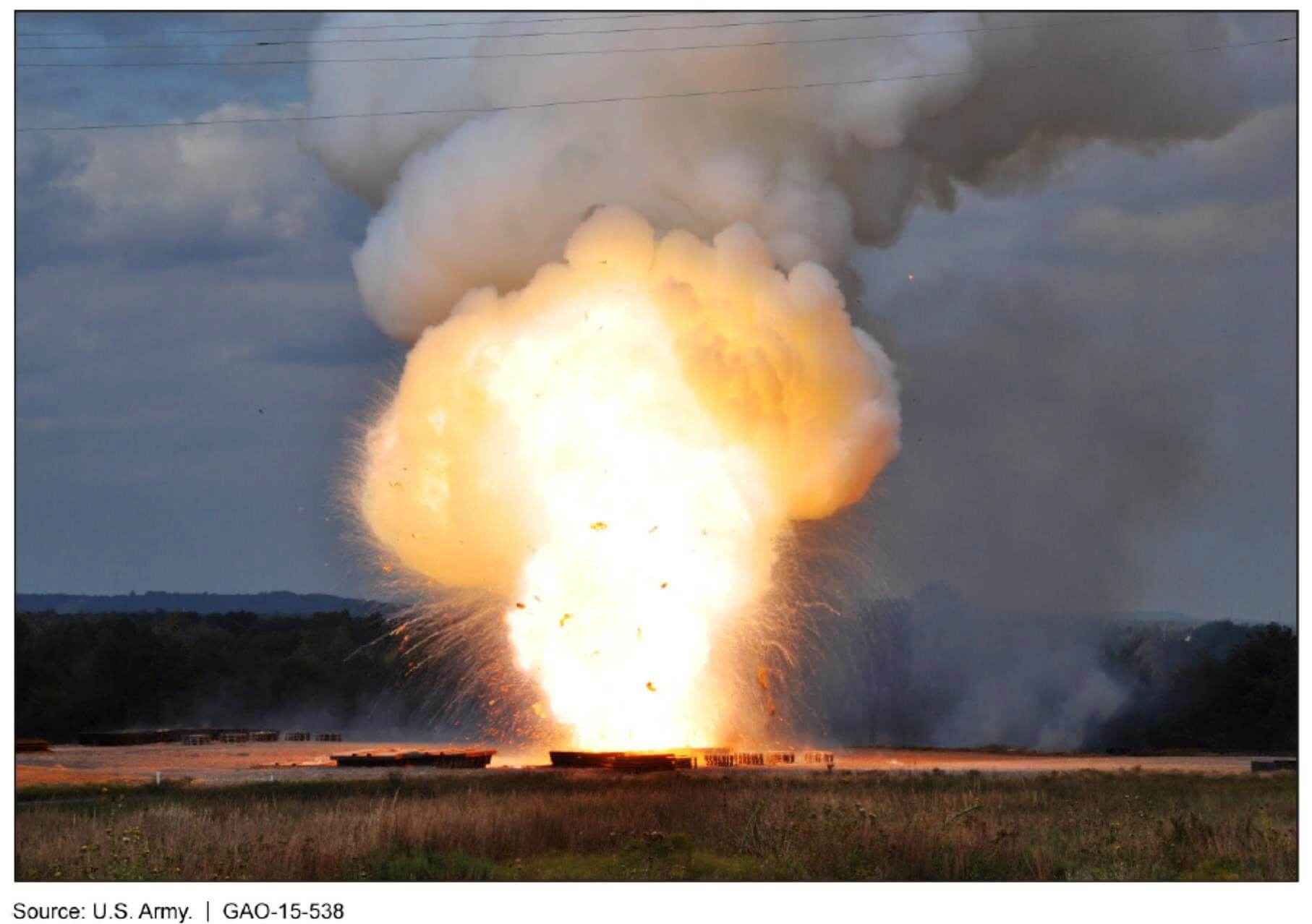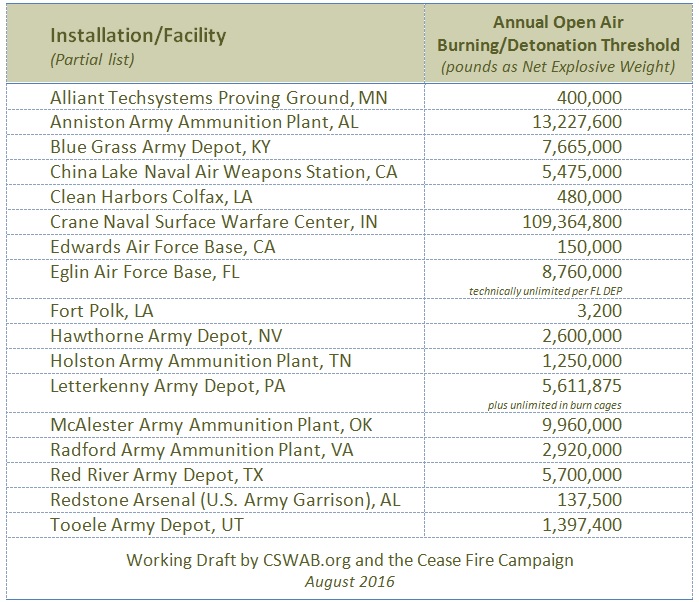
About the Cease Fire Campaign
The CEASE FIRE Campaign seeks to protect human health and the environment by calling for the immediate implementation of safer alternatives to open air burning, detonation and incineration/combustion of military munitions.
These alternatives must incentivize waste prevention and recycling; prevent, to the greatest possible extent, the release of toxic emissions and pollutants; and advance the principles of environmental justice by assuring that all people enjoy the same degree of protection and access to the decision-making process. We pursue these goals through peaceful non-violent action and democratic organizing consistent with the Jemez Principles.
So far, 68 social justice, environmental health, tribal, veterans service and conservation groups have endorsed the Cease Fire Campaign’s goal statement. You can view our list of participating organizations. Voice your support by signing our petition to EPA.
Conventional munitions stockpile
The Secretary of the Army serves as the single manager for conventional ammunition and is responsible for demilitarizing the U.S. Department of Defense’s conventional (non-nuclear/non-biological/non-chemical) ammunition stockpile and more than 300,000 missiles and missile components. The U.S. Army Audit Agency reported that this stockpile had grown to more than 557,000 tons as of March 2009 and could exceed 1.1 million tons by FY 2025 representing a $2.8 billion demilitarization liability.
The U.S. government is considering two treaties that, if ratified, would significantly impact U.S. demilitarization operations. One treaty is the Convention on Cluster Munitions and the other is the Convention on the Prohibition of the Use, Stockpiling, Production and Transfer of Anti-Personnel Mines and on Their Destruction. DOD has an inventory of 471,726 tons of cluster munitions and 23,436 tons of anti-personnel landmines that will have to be disposed of if the United States ratifies the two treaties.
All munitions have a finite service life and will at some state need to be either expended or disposed of. Disposal can involve dumping, resale and demilitarization. The three major types of demilitarization are uncontained thermal treatment such as Open Burning and Open Detonation (OB/OD), contained industrial thermal treatments such as incineration, and other industrial treatments such as oxidation and biodegradation.
OB/OD and incineration
Open detonation of ammunition causes the dispersion of heavy metals (cadmium, chromium, lead, etc.), energetic compounds, perchlorate, nitrogen oxides and other munitions-related contaminants to the environment. It is typically conducted directly on the ground surface, in open pits or trenches, or via buried charges.
Open burning is still routinely used for disposal of propellants and pyrotechnics. It is conducted on the ground surface or in burn pans. Dunnage (such as wood) and supplemental fuels (such as fuel oil or kerosene) are often added to aid the burning. Like detonation, open burning produces an uncontrolled release of toxins to the air and the surrounding environment.
An incinerator (combustor) is a facility for the controlled burning of waste which can emit dioxins, PCBs, heavy metals, polycyclic aromatic hydrocarbons and other contaminants. Incinerators with names like gasification, pyrolysis, plasma arc, and waste-to-energy all emit dioxins and other harmful pollutants. However the core environmental impacts of all types of incinerators are the same.
Beginning in 2000, some countries progressively moved away from OB/OD. That year, the Canadian Department of National Defence instituted severe restrictions on OB/OD operations as a result of reports of environmental contamination at several Canadian Forces bases and ammunition depots. A number of countries, notably Germany, the Netherlands, and Sweden, have banned OB/OD if alternative processes are available.
Prescribed range fires, decontamination ovens, and open burning of explosives-contaminated buildings and other infrastructure are other sources of uncontrolled toxic releases to the environment. The prescribed range fires at Fort Ord, California, for example, are intended to clear vegetation in order to facilitate the recovery and removal of unexploded ordinance and munitions. However, high levels of smoke lead to poor air quality due to an increase in fine particulate matter (PM). Inhalation of PM has been linked to increased risks of heart attacks, strokes and respiratory ailments.
Sustainable alternatives
In the past 25 years, alternatives to the incineration of hazardous waste have emerged due to the work of communities, EPA, and the Department of Defense (DOD). These technologies are being used by the DOD to destroy energetics and chemical warfare agents. These technologies could be readily applied to conventional munitions and other types of hazardous waste.
Under the Assembled Chemical Weapons Assessment program, the military established a process for identifying and demonstrating alternatives to incineration for the demilitarization of chemical weapons. Seven of these technologies were evaluated for applicability to RCRA hazardous waste: chemical oxidation, chemical reduction (2), biological degradation, supercritical water oxidation (2), and thermal plasma. Based on information provided by technology providers, an EPA report published in 2000 found that all seven of these technologies have the potential to treat a wide range of RCRA waste streams including energetics. Unlike incinerators, these alternatives are designed and operated so that they will not produce dioxin or dibenzofurans, technology providers said.
 In 2001, a report by the National Research Council (NRC) committee identified technologies for disposal of “non-stockpile” chemical weapons wastes that pose low risk to workers and communities, compared to incineration. Non-stockpile chemical weapons are a category of warfare materials leftover from chemical weapons production, testing and training. The NRC committee’s report, “Disposal of Neutralent Wastes,” examined eight non-incineration disposal processes and ranked them by criteria such as safety, technical effectiveness and pollution prevention. The committee found that “the benefits of [some non-incineration] technologies over incineration include low worker risk, public acceptance, low risk to the surrounding community, and simplicity of operation.”
In 2001, a report by the National Research Council (NRC) committee identified technologies for disposal of “non-stockpile” chemical weapons wastes that pose low risk to workers and communities, compared to incineration. Non-stockpile chemical weapons are a category of warfare materials leftover from chemical weapons production, testing and training. The NRC committee’s report, “Disposal of Neutralent Wastes,” examined eight non-incineration disposal processes and ranked them by criteria such as safety, technical effectiveness and pollution prevention. The committee found that “the benefits of [some non-incineration] technologies over incineration include low worker risk, public acceptance, low risk to the surrounding community, and simplicity of operation.”
Although focused on chemical weapons destruction, many of the techniques reviewed have application to conventional weapons as well. These technologies include Supercritical Water Oxidation, Detonation of Ammunition in a Vacuum-Integrated Chamber, and Detonation Chambers.
In many cases, resource recovery can be more cost effective than incineration. In 2001, the Department of Defense reported that small arms ammunition was demilitarized by a private contractor through a resource recovery methodology at a cost of $1 a ton versus $1,200 to $1,500 per ton for incineration at a government facility.
With the passage of the National Defense Authorization Act in 2007 passage, the Army gained the legal authority to sell recyclable munitions materials resulting from demilitarization and reinvest the proceeds into R3 operations. Proceeds from the reinvestment are estimated at $2-3 million annually. The new law complimented other existing demilitarization initiatives – the Demil Research and Development Program which focuses on disassembly and reusing existing munitions and Design for Demil which seeks to influence future munitions design for easier disassembly.
While capabilities exist to deal with most surplus munitions, new energetic materials and new munitions are becoming more and more complex. Before 1990 almost all new munitions had energetics that were TNT based – today this is rarely so. The increasing variety of energetics will increase both the difficulty and cost of disposal.
Burn pits in Afghanistan and Iraq
From the start of military operations in Afghanistan and Iraq, the U.S. military and its contractors burned solid and hazardous waste in open burn pits on or near military bases. At the Balad Air Base in Iraq, up to 227 metric tons of waste were burned daily including asbestos, solvents, unexploded ordnance, hydrogen cyanide, batteries, tires, plastics, and medical wastes. Military jet fuel was used as an accelerant. The military’s burn pits emitted particulate matter laced with heavy metals and toxins like sulfur dioxide, arsenic, dioxins, and hydrochloric acid that are linked to serious health ailments. Among them are chronic respiratory and cardiovascular problems, allergies, neurological conditions, several kinds of cancer, and weakened immune systems.
For more information
Email: info@cswab.org
Phone: 608/643-3124
http://www.facebook.com/ceasefirecampaign





